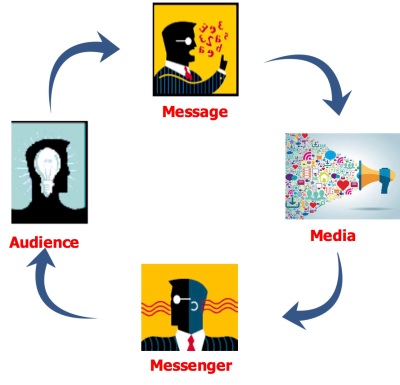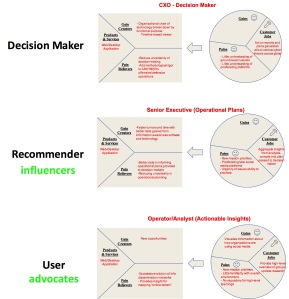Steve Blank es el co-creador de la metodología que utilizamos en el marketing «Lean», el marketing de las start ups y de las grandes empresas pegadas a sus clientes, que empiezan saliendo a la calle con una idea de producto/negocio para escuchar, empatizar y comprender a sus clientes target (con el «design thinking»), utilizando un proceso de «desarrollo de clientes» en 4 fases que se soporta con unos modelos de negocios a validar («business model canvas») y con un prototipo («Producto mínimo viable») siempre delante, aplicando «lean start up» para mejorarlo y adaptarlo a lo que descubramos en el proceso.
Pasamos de un «mapa de empatía» de clientes a un «mapa de propuesta de valor» y una vez garantizado que hay suficiente clientes interesados en nuestro producto («customer discovery y customer validation»), escalamos nuestro proceso de co-creación a las fases de «customer creation y company building», lanzando el producto/montando la empresa, siempre con la posibilidad de volver hacía atrás (pivotar) y probar con un nuevo modelo de negocio (canva) si no validamos las hypótesis definidas.
En este post, Steve comparte sus ideas sobre como «comunicar» utilizando 4 etapas que van desde la comprensión de la audiencia, a la composición del mensaje, la selección de los media y los mensajeros adecuados.
Everything You Ever Wanted to Know about Marketing Communications
I was having coffee with the CEO of a new startup, listening to her puzzle through how to communicate to potential customers. She was an academic on leave from Stanford now selling SAAS software to large companies, but was being inundated with marketing communications advice. “My engineers say our website is old school, and we need to be on Facebook, Twitter and Instagram, my VP of Sales says we’re wasting our marketing dollars not targeting the right people and my board keeps giving me their opinions of how we should describe our product and company. How do I sort out what to do?”
She winced as I reminded her that she had gone through the National Science Foundation Innovation Corps. “Painful and invaluable” was her reply. I reminded her that all the Lean tools she learned in class–Customer Discovery, business model and value proposition canvases– contained her answer.
Here’s how.
—-
Define the Mission of Marketing Communications
Companies often confuse communications tactics (“What should my webpage look like or should I be using Facebook/Instagram/Twitter?”) with a strategy. A communications strategy answers the question, “Why are we doing these activities?” For example, our goal could be:
- Create demand for our products and drive it into our sales channel
- Create awareness of our company and brand for potential customers
- Create awareness for fundraising (VC, angels, corporate partners)
- Create awareness for potential acquirers of our company
(Marketing communications is a subset of the Marketing department’s mission. Read the post about mission and intent here.)
Audience(s), Message, Media, Messenger
Once you figure out why you’re creating a communications strategy then you can figure out how to use it. The “how” requires just four steps:
- Understand your audience(s)
- Craft the message for that specific audience
- Select the media you want the message to be read/seen/heard on
- Select the messenger you want to carry your message

Step 1: Who’s the Audience(s)?
An audience means – who specifically you want your messages to reach. Is it all the people on earth? Everyone in San Francisco? Potential customers such as gamers who like to play specific types of games? Or people inside companies with a specific title, like product or program managers, CIOs, etc? Venture Capitalists who may want to invest? Other companies that may want to acquire you?
What’s confusing is that often there are multiple audiences you want to communicate with. So, refer to your strategy: Are you trying to reach potential customers or potential investors and acquirers? These are very different audiences, each requires its own messages, media and messengers.
If you’re selling a product to a company, for example, is the audience the user of the product? Her boss? The person who has the budget? The CEO?
How do you figure out who the audience is? It turns out that if you’ve been doing customer discovery and using the value proposition canvas, you know a lot about each customer/ beneficiary. The first step is to put all those value proposition canvases on the wall to remind you that these are the people you need to reach.
How do you figure out which of these customers/beneficiaries is most important? Who’s the least important? If you’ve been out talking to customers, you will have an idea of who’s involved in the buying process. Who’s the user of product? The recommender? The decision maker? The saboteur? As you map out what you learned about the role each of these customers plays in the buying process, marketing communications and sales can decide which one of the customers/beneficiaries is the primary audience of your messages. (And they can decide if there any secondary audiences you should reach.) Often there are multiple people in a sales process worth influencing.
If you’re trying to reach potential acquirers or investors, the customer discovery process is the same. Spend time building value proposition canvases for these audiences.
Step 2: What’s the Message?
Messages are what you delivering to the audience(s) you’ve selected. Messages answer three questions:
- Why should the audience care?
- What are you offering?
- What’s the call to action?
Your customers have already told you how to craft the first part of your message. The answer to “Why should your audience care?” comes directly from the pains and gains on the right side of the value proposition canvas.
And the answer to the second question “What are you offering?” comes from the left side of the value proposition canvas. It’s not just the product feature list, but the pain relievers and gain creators.
Once you get your audience to read your message, then what? What’s the call to action? Do you want them to download a demo, schedule a sales call, visit a physical store location or a website, download an app, click for more information, give you their email address, etc.? Your message needs to include a specific call to action.
Other things to keep in mind about messages:
Message context
A message that is brilliant today and gets the press writing about you and customers begging to buy your product could have been met with blank stares two years ago and may be obsolete next year. In crafting your messages, remember that all messages operate in a context that may have an expiration date. Netbooks, 3DTVs, online classes disrupting higher ed, all had their moment in time. Make sure your context is current and revisit your messages periodically to see if they still work.
Sticky Messages
Messages also need to be memorable – “sticky.” Why? Because the more memorable the message, the greater its ability to create change. Not only do we want people to change their buying behavior, we also want them to change how they think. (This is often a tough concept for engineering founders who believe that if we just tell customers about the features that make their product faster, cheaper, etc. they’ll win.)
Consider that if you were told you were going to pay for cold, dead fish wrapped in seaweed you might not be too hungry. But when we call it sushi people line up.
The same goes for a hamburger. You may eat a lot of them, but if McDonald’s message was “dead cow, slaughtered by the millions, butchered by minimum wage earners, then ground into patties, frozen into solid blocks, and reheated when you order them,” instead of “You deserve a break today,” sales might be a tad lower.
Product versus Company Messages
There is a difference between detailed product messages versus messages about your company. At times, you may have to communicate what the company stands for before a customer is ready to listen to you talk about product messages. For example, to outflank a competitor who had faster products, Intel moved the conversation about microprocessors away from speed and technology to create a valued brand. They created the “Intel Inside” campaign.
Apple was trying to resurrect a then-dying company by reminding people what Apple stood for with their “Think Different” ad campaign
Both Apple and Intel were selling complicated technology but did so by simplifying the message so it had broad emotional appeal. Both Intel Inside and Think Different became sticky corporate messages.
Step 3: Media
Media means the type of communications media each audience member reads/listens to/watches. Is could be print (newspapers/magazine), Internet (website, podcasts, etc.), broadcast (TV, radio, etc.) or social media (Facebook, Twitter, etc.). In customer discovery, you asked prospects how they get information about new companies and new products. (If not, get back out and do so!) The media your prospective customers told you they use ought to be on top of your target media.
The online media your company controls (your corporate website, company Facebook page, Twitter, Instagram, etc.) should be the first place you experiment finding your audience(s) and message.
Typically, you pick several media to reach each audience. It’s likely that each audience reads different media (potential customers read something very different than potential investors.) You’ll need a media strategy – a plan that describes the mix of media and how you will use it. This plan should include the category of media; print, internet, broadcast and then identify specific sites, blogs, magazine, etc.
Step 4: Messengers
Messengers are the well-placed and highly leveraged individuals who have influence over your audience(s). Messengers convey and amplify your message to your audience through the media you’ve chosen.
There are four types of messengers: reporters, experts, evangelists and connectors. (Each audience will have its own unique set of messengers.)
Reporters are paid by specific media to write about news. Which reporters you should talk to comes from discovering which media your audience has said they read. Your goal is to identify who are the reporters in the media your audience reads and what they write about, and to figure out why they should write about you. (Wrong answer – because we have a new product. Very wrong answer – because my CEO wants to be on the cover of publication X or Y.)
Experts know your industry or product in detail, and others rely on them for their opinions. Experts may be industry analysts in private research firms (Gartner, NPD, AMR), Wall Street research analysts (Morgan Stanley, Goldman Sachs), consultants who provide advice for your industry or bloggers with wide followings. Experts may even be potential customers who run user groups that other potential customers turn to for advice.
(Today some reporters are experts – product reviewers in the Tech Section of the Wall Street Journal, or the Technology section of the New York Times (or its product review site Wirecutter)).
Evangelists are unabashed cheerleaders and salespeople for your product and, if you are creating a new market, for your company vision. They tell everyone how great the product is and about the unlimited potential of your product and market. While nominally carrying less credibility than experts, evangelists have two advantages: typically, they are paying customers, and they are incredibly enthusiastic about what they say. (Evangelists are not customers who will give a reference. A customer reference is something you have to twist arms to get; an evangelist is someone you can’t get off the phone.)
Connectors are individuals who seem to know everyone. Each industry has a few. They may be bloggers who expound on the general state of your industry and write magazine or newspaper columns. They may be individuals who organize and hold conferences where the key industry thought leaders gather. Often, they themselves are the thought leaders.
Founders ask me all the time whether they should hire a PR agency. I tell them, “The question isn’t if. The question is when?” Influencing the messengers is what great public relations firms know how to do. They may have their own language describing who the messengers are (e.g., “influencers”) and how they manage them (e.g. “information chain”), but once you’ve done a first pass of the audience > message > media > messenger, a competent PR firm can add tremendous value.
Customer Discovery Never Stops
Understanding your audience(s) is important for not just startups, but for companies already selling products. It helps you stay current with customers, get ideas for other needs to fill and to create new products. In addition, the audience > message > media > messenger cycle seamlessly moves this learning into getting, keeping and growing customers. Today, Marketing Automation tools (customer analytics, SEO, and Customer Relationship Management (CRM) platforms) generate customer behavior history about what messages worked on which media. These tools generate data that companies use to feed AdTech tools (demand-side platforms, ad exchanges and networks) to automate selling and buying of online ads.
Communications as a Force Multiplier
- Smart CEOs treat communications as a force multiplier for sales, a tool to dramatically increase valuation and the vehicle to get acquirers lined up at the door. Not so successful CEOs treat it as tactic that can be handed to others.
- Hiring a PR agency too early is a sign that the CEO is treating this as someone else’s problem. In a startup, the first pass of understanding Audience, Message, Media, Messenger can only be done with the founders/CEO engaged.
- Getting publicity for a product that does not yet exist is how startups get noticed. But don’t fall victim to your own reality distortion field and hype a product that can never be made (think of Tesla versus Theranos.)
- Figuring out who the possible audiences are, what messages to send, and what media to use, feels overwhelming at first. The temptation is to try to reach all the audiences with a single message and a single media. That’s a going out of business strategy. Use Customer Discovery, and your customers will teach you who they are, what to say to them and how to reach them.
Lessons Learned
- Marketing Communications = Audience, Message, Media, Messenger
- Use the Value Proposition Canvas to understand who your audience(s) are
- Craft messages to match what your audience has already told you
- Pick the media they said they read
- Find the right messengers to amplify your message

